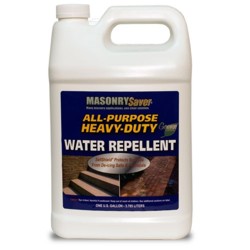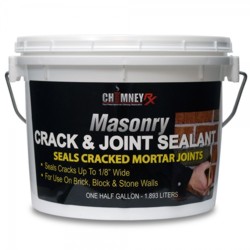Brick and Masonry Water Repellents
Brick & Masonry Water Repellents
Brick, concrete block, stucco and mortar can absorb massive quantities of water. In fact, bricklayers often cover brick and block piles on the jobsite to protect them from rain. The reason is simple. Brick and block have a property referred to as 'suction'. This suction draws water from wet mortar into a brick or a block when it is laid. This, in turn, rapidly stiffens the wet mortar. This stiffening allows the bricklayer to continue to lay row after row of block and brick. If bricks absorb too much water, they can't suck water from the mortar. When this happens, the brick or block 'swims' in the wall.
Like a Sponge (Hum....)
Those of us who live in areas that experience freezing weather can testify to the power of freezing water. Allow water to soak into a brick, let that water freeze, and BINGO, major problems soon develop.

Efflorescence growing in the mortar of a brick fireplace. PHOTO CREDIT: Michael Hannum
Many people have experienced efflorescence (white salt deposits) on brick or block. Efflorescence is made possible by the tiny passageways in brick, block and mortar. Water travels right through a brick and dissolves the salts. These salts deposit on the surface of a brick after the water evaporates.
100 Years Ago
Many people have houses built from reclaimed or 'used' brick. These brick were often fired in low temperature kilns. The outer face each brick would vitrify (get hard), but often the core would remain relatively soft. Some bricks were harder than others depending upon their location within the kiln. It was an inexact science.
New brick are not all the same. Some new brick can be very soft. The clay used to make the brick can be of poor quality. The manufacturer may cut costs by reducing the amount of time the brick spend in the kiln. Quality control may be non-existent.
The point is this, in order to protect your brick structure, you may have to consider using some of the new clear masonry coatings. However, as in all things, there is a big difference between products you may be considering.
Sealers vs. Repellents
During the past 25 years, there has been an explosion of products that can be used to 'seal' masonry surfaces. The problem is, some things should be sealed and others should not.
My Webster's Dictionary defines seal as "a tight and perfect closure (as against the passage of gas or water)". Hmmmmmmmm, do you see the problem? A true sealer will totally block the passage of water. In fact, it will most likely block it no matter which direction it is headed (into or out of the item being sealed).
There are two primary categories of colorless coatings that you might apply to brick or masonry surfaces: film forming sealants and penetrants.
A film forming sealant produces a thin, solid film on the surface. A penetrant, on the other hand, is absorbed into the brick or masonry.
Sealants
Sealants work great if you are trying to coat brick or masonry to prevent absorption of oil, paint (graffiti), chemicals, etc. They also do a fantastic job of keeping water from entering brick or masonry. However, they have serious drawbacks.
Sealants can inhibit, or stop, the ability of a brick or masonry surface to breathe. Because they form a film at the surface of the brick or surface, they stop trapped water or water vapor from escaping into the atmosphere. In colder climates, this can cause brick spalling (flaking) when water, trapped behind the sealant, freezes, expands and fractures the brick or masonry.
Film forming sealants can also trap dirt, discolor, change the color of the masonry or brick, and produce a sheen or gloss when applied.
Sealant Ingredients
Film forming sealants often contain one or more of the following principal ingredients: acrylics, stearates, mineral gum waxes (paraffin), urethanes, and silicone resins. All of these ingredients act like paint when they come into contact with brick or masonry. They simply 'stick' to the surface and form a film. Some sealants are so heavy bodied that they can bridge small hairline cracks.
On a microscopic level, sealants are 'big'. Their large molecular structure does not allow them to penetrate into the small passageways in brick, block, stucco and mortar.
Often the principal ingredients of a sealant are listed on the product label. If you see any of the above things mentioned, you very likely are dealing with a sealant. Don't be fooled by labeling that says 'Sealant - Water Repellent'. Yes, sealers repel water, but you may want a product that breathes.
Penetrants
Penetrating clear coatings are, in almost all instances, the top performer. These products are excellent water repellents. They have a great ability to penetrate deeply, sometimes up to 3/8 inch into a brick or masonry surface.
Penetrants do not form a film on the surface of brick or masonry. Rarely do they change the appearance or color of the surface. They are able to penetrate because of their tiny molecular structure. These products coat the insides of the tiny passageways of the brick and mortar.
The primary ingredients of penetrants are silanes, siloxanes, or a blend of these ingredients. Note that these two ingredients look very similar to silicone. Do not confuse them!
Silanes have a very small molecular structure. They can penetrate deeply into masonry surfaces. Siloxanes have a slightly larger molecular size, but they also penetrate quite well. The interesting thing is that both of these compounds can chemically bond to the silica and alumina minerals often contained in brick, block, stucco and mortar. This bonding property and their ability to penetrate make for long service lives. Often these penetrating compounds can last in excess of ten years!
Be sure to read product labels. If the label doesn't say what it contains, call the manufacturer and ask. Always ask for the technical department when calling.
Over the years, I've seen many different spellings of efflorescence. Here's my growing list: effervesce, effervescence, effervescent, effleresants, effloreflance, efflorescence, efflorressance, effluorescence, eflorescence, eflorescents, ellforesce and ifflorescence.
Related Articles:Brick Veneer Leakage, Brick Water Repellents, Brick Leaks
 |
 |
The above product links are affiliate links. I get a tiny commission if you purchase these from Amazon.
4 Responses to Brick and Masonry Water Repellents